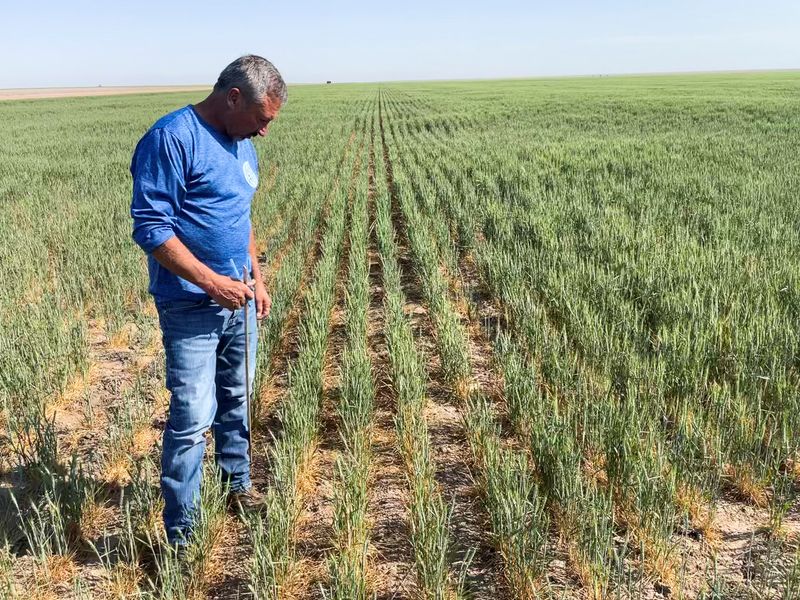By Karl Plume
(Reuters) - North Dakota farmer Dwight Grotberg wanted to plant more wheat this spring to capitalize on soaring prices since Russia's invasion of Ukraine cut grain exports and left the world short of millions of tonnes of wheat supply.
Heavy rain has prevented Grotberg from planting as much wheat crop as he wanted and is hampering farmers across the state, the top U.S. grower of spring wheat.
Instead of boosting supply, North Dakota expected to plant wheat over the smallest share of its farmland on record, according to government data.
The United States is the world's fourth-largest wheat exporter and problems are hitting output at a time when the world can ill afford to lose any more supplies of the staple grain amid a global food crisis.
Benchmark Chicago Board of Trade wheat prices surged 50% to more than $13.60 a bushel after Russia's invasion in February halted shipments of nearly a third of the world's wheat exports, and little has gone right for wheat since then.
Worsening harvest prospects in China and parts of Europe, followed by an export ban by major producer India, have tightened stocks and exacerbated global food supply concerns.
The United Nations has warned the impact of the war on grains, oils, fuel and fertilizer could throw millions of people into famine and take years to resolve.
Washington has been calling on U.S. farmers to seed more winter wheat this autumn, and the government said it would allow planting on some environmentally sensitive land beginning this fall. But the drought and costly farm inputs could limit production gains, say grain analysts.
There are two wheat crops in the United States: spring wheat planted now, and winter wheat planted in autumn that will be harvested soon. Both are in trouble.
The problems with the spring wheat planting faced by farmers like Grotberg come after drought hit the winter wheat crop in Kansas, the top growing state.
The U.S. winter wheat harvest potential there has fallen by more than 25% due to severe drought. Kansas farmers may abandon thousands of acres of wheat in fields this year, instead of paying to harvest the drought-scorched grain.
Back in North Dakota, it is too much water that is the problem. An historic April blizzard left the state's expansive, pothole-dotted fields under more than 3 feet (1 m) of snow in some areas, triggering floods as the deluge melted.
Grotberg has only been able to plant about 500 acres (200 hectares) with wheat so far - just a quarter of the land he had aimed to sow - because of the wet conditions.
Seeds sown in soggy soils can struggle to emerge or come up unevenly, while heavy farm machinery can tear up overly muddy fields, compact soils or get lodged in the muck.
Now, Grotberg's planting window is closing fast.
Wheat planted too late in the spring is likely to yield less grain or be at risk of frost before the crop fully ripens.
"We're stuck ... Normally we're wrapping up wheat planting by this time," Grotberg said.
SLOWEST SPRING PLANTING SINCE 1996
Soggy spring weather has all but ensured that the northern U.S. Plains breadbasket will not produce a bumper crop this year.
U.S. farmers have only seeded 49% of their intended spring wheat acres as of May 22, matching 2014 for the slowest pace since 1996, according to U.S. Department of Agriculture data.
In North Dakota, which produces about half of U.S. spring wheat, growers have planted just 27% of their crop, the second slowest pace in four decades.
"Some farmers have not turned a wheel yet," said North Dakota Agriculture Commissioner Doug Goehring. "If North Dakota is not able to get a substantial amount in, it's just going to wreak more havoc on the global market."
ABANDONING SHRIVELED WINTER WHEAT
In the southern U.S. Plains, winter wheat farmers have received very little rain and are concerned about the size of their harvest - or if the shriveled plants will simply need to be plowed under.
A private group touring wheat fields in Kansas in mid-May forecast its harvest would shrink by 28% this year and more fields than normal may go unharvested due to drought damage.
About 6% of the state's planted acres would be abandoned, according to the latest USDA estimates. But given the drought damage, Kansas State University wheat agronomist Romulo Lollato thinks the abandonment rate would be higher.
"I would not be surprised if 8%, 9%, 10%" of planted acres are abandoned this year, Lollato said.
In neighboring Colorado, abandonment could top 30%, Colorado Wheat Executive Director Brad Erker told tour participants.
"Wheat yields are affected by weather in May, and we've had a really dry May," said Kansas farmer Vance Ehmke. "The trend is not our friend."
DISAPPEARING WHEAT ACRES
U.S. wheat output has been on longer-term decline as farmers favored corn and soybean production, which are more lucrative due to demand from biofuels producers. Seed science also has boosted their yields by 30% or more since 2000, outpacing just 6% for wheat.
Biofuels demand is likely to continue to erode wheat acres as two new soy processing plants are set to open in eastern North Dakota, including one by Archer-Daniels-Midland Company (NYSE:ADM) that will supply Marathon Petroleum Corporation (NYSE:MPC) with soyoil for renewable diesel fuel.
As the planting window in the northern Plains narrows, North Dakota farmers are weighing options that include shifting to soybeans, which can be sown later in the spring than wheat, or filing prevented planting insurance claims.
"It gets pretty tempting to file those claims," Grotberg said. "Once you get into June, you might be lucky to get half a crop. And with costs as high as they are, that's hard to stomach."
